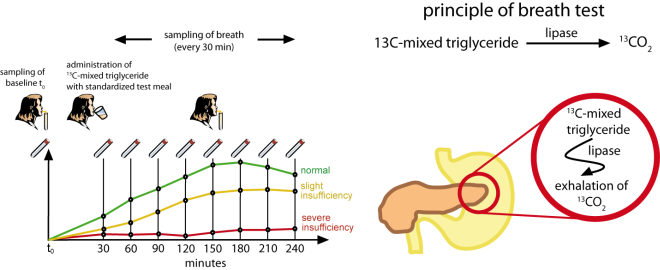



A decrease in lipase activity is an early indicator of pancreatic malfunction. Pancreo-Lip is a ¹³C-Mixed Triglyceride breath test to determine pancreatic malfunction by determining lipase activity in vivo.
Direct pancreatic function tests such as the secretin-caerulein test are not suitable for routine diagnostic use because they are time consuming, expensive, invasive and not internationally standardised. Indirect tests such as the fluorescein dilaurate test, and faecal chymotrypsin activity all have limited sensitivity. The determination of faecal elastase 1 is the most promising test in current use but has all the drawbacks associated with stool tests.
Vantrappen et al. (Gastroenterology, Vol 96, 126-134, 1989) first described a pancreatic lipase breath test using a ¹³C labelled mixed triglyceride substrate. Since this time a number of authors have further evaluated the test. Clinical investigations carried out in collaboration with INFAI (Löser et al. Scand. J. Gastroenterol. Vol 33, 327-334, 1998) have demonstrated that the test is a valuable diagnostic tool for identifying pancreatic insufficiency.
INFAI is completing clinical trials for this test in preparation for an application for a Europe-wide Marketing Authorisation. The kit is currently available for use on a named patient basis and for research applications providing the appropriate ethical permissions and licence exemptions are in force.

¹³C-Mixed Triglyceride (200 mg Glyceryl 1,3-Dioctadecanoate 2-octanoate-1-¹³C in pure powder form) when mixed with chocolate cream and administered in a test meal with toast and bread is hydrolised by pancreatic lipase. One of the products of this hydrolysis, ¹³C-Octanoic acid, is rapidly catabolised in the liver to 13CO2 which is released in the breath. The characteristics of the 13CO2 excretion curve can be used to distinguish normal and pathologic levels of pancreatic lipase activity.
After a six hour fast patients ingest a standardised testmeal consisting of ¹³C-Mixed triglyceride (200 mg Glyceryl 1,3 Dioctadecanoate 2 Octanoate-1-¹³C as a pure powder) mixed with chocolate cream (10g) and spread onto a slice of toast (100g) and butter (15g). The test meal is accompanied with a 150 ml cup of coffee, tea or water.
The test protocol for Pancreo-Lip is convenient and patient friendly and takes approximately 250 minutes. It is recommended that the test is carried out with the patient in a resting position. The test is initiated by taking the baseline breath samples. The patient blows gently through a plastic straw into a glass tube which is sealed with a rubber stopper. Two baseline samples are taken after which the patient eats the testmeal. When the test meal is finished a further 8 breath samples are taken at 30 minute intervals. The sample tubes are placed in the original kit pack and sent to a qualified laboratory for 13CO2 determination.
The 13CO2 excretion curves are analysed mathematically using a procedure developed by INFAI which permits the identification of various levels of pancreatic insufficiency.